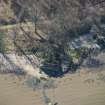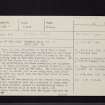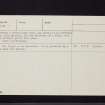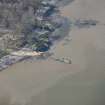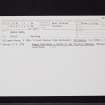Eagle Rock
Rock Carving (Period Unknown)
Site Name Eagle Rock
Classification Rock Carving (Period Unknown)
Alternative Name(s) Hunter's Craig; Dalmeny Beach
Canmore ID 50390
Site Number NT17NE 11
NGR NT 1845 7743
Datum OSGB36 - NGR
Permalink http://canmore.org.uk/site/50390
- Council Edinburgh, City Of
- Parish Dalmeny
- Former Region Lothian
- Former District City Of Edinburgh
- Former County West Lothian
Eagle Rock, Dalmeny, West Lothian, carved rock face
Measurements: sunken niche H 1.07m, W 0.76m, D 0.1m
Stone type:
Place of discovery: NT 1845 7743
Present location: on rock face above foreshore.
Evidence for discovery: first recorded by Wood in 1794 as traditionally thought to be a frontal eagle but it was already too worn to make out. At some point between 1926 and 1974 an iron grille was added to protect the carving, and this was removed before 1996.
Present condition: extremely weathered.
Description
Within a small sunken carved niche some 0.25m above the foreshore are the remains of a figure carved in relief. Rather than an eagle, Keppie suggested that it might represent either Mercury, god of travel and trade, or some local Genius or spirit (1986, 113). Its identification is uncertain owing to its poor state of preservation.
Date range: uncertain
References: Wood 1794; RCAHMS 1929, no 330; Keppie 1986, 113.
Desk-based information compiled by A Ritchie 2016
NT17NE 11 1845 7743
(Name: NT 1849 7745) HUNTER'S CRAIG (R) or EAGLE ROCK (R)
OS 25" map, (1964).
Wood, in 1794, describes, on the E face of Eagle Rock, 'a sculpture bearing some resemblance to the figure of an eagle, standing upright, with its back to the rock, supposed by some to have been executed by the Romans. All traces of the figure are now worn away.' (J P Wood 1794). The artificially cut niche containing the sculpture is c 10' above the beach. Its greatest height is c 3 1/2', at the bottom 2 1/2' wide and 8 1/2" deep. The sculpture stands out c 4 1/2" in relief, but is now badly worn, and little can be made out, apart from the fact that there is something cut on it.
In view of the proximity of the Cramond Roman fort, it is not improbable that this sculpture is Roman work.
It is more doubtful whether it represented an eagle; a figure of Mercury would be more in place. (RCAHMS 1929).
Ross, however, states that the figure depicted was apparently a horned human head, and quotes it as evidence, among other material, for the existence of a Celtic cult or an antlered god in this area.
RCAHMS 1929, visited 1926; A Ross 1967.
The figure is as described. It is protected by a close mesh iron grille.
Visited by OS (SFS) 19 August 1974.
Situated on a rocky outcrop on Dalmeny beach. The figure is as described although the protective iron grill is no longer in place (NMR 1974) The figure is open to continuous weathering and possible human disturbance.
Site recorded by GUARD during the Coastal Assessment Survey for Historic Scotland, 'The Firth of Forth from Dunbar to the Coast of Fife' 17th February 1996.
Publication Account (1753)
Stone with eagle carving.
Maitland 'Hist of Edin' 1753 IX 508,
Field Visit (1996)
Situated on a rocky outcrop on Dalmeny beach. The figure is as described although the protective iron grill is no longer in place (NMR 1974) The figure is open to continuous weathering and possible human disturbance.
Site recorded by GUARD during the Coastal Assessment Survey for Historic Scotland, 'The Firth of Forth from Dunbar to the Coast of Fife' 17th February 1996.















